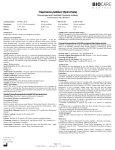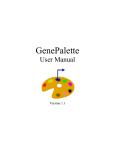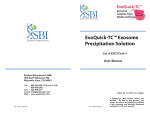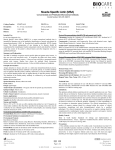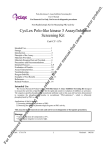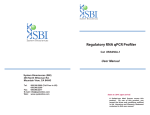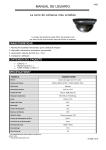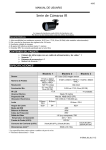Download TTF-1 [SPT24] - Zytomed Systems
Transcript
TTF-1 [SPT24] Concentrated and Prediluted Monoclonal Antibody Control Number: 901-3126-011515 Catalog Number: ACI 3126 A, C API 3126 AA OAI 3126 T70 Description: 0.1, 1.0 ml, concentrated 6.0 ml, prediluted Dilution: 1:100-1:200 Ready-to-use 70 tests, prediluted Ready-to-use Diluent: Renoir Red N/A N/A Intended Use: For In Vitro Diagnostic Use TTF-1 [SPT24] is a mouse monoclonal antibody that is intended for laboratory use in the qualitative identification of TTF-1 protein by immunohistochemistry (IHC) in formalin-fixed paraffin-embedded (FFPE) human tissues. The clinical interpretation of any staining or its absence should be complemented by morphological studies using proper controls and should be evaluated within the context of the patient’s clinical history and other diagnostic tests by a qualified pathologist. Summary and Explanation: Thyroid transcription factor-1 (TTF-1) is a 38 kDa member of the NKX2 family of homeodomain transcription factors. TTF-1 is mostly detected in primary lung adenocarcinomas and small cell carcinomas (1). TTF-1 can be very useful in lung cancers when used in a panel with Desmoglein 3, p40 and Napsin A antibodies (2-3). Commercially available thyroid transcription factor-1 (TTF-1) monoclonal antibodies 8G7G3/1 and SPT24 have been shown to have different sensitivities in lung adenocarcinomas (LADC) and lung squamous cell carcinomas (SqCC) (4-6). A study by Masai, et al. demonstrated that SPT24 was much more sensitive than 8G7G3/1 in LADC (72.4% and 65.4% respectively). However, the study demonstrated that SPT24 stained a higher percentage of lung SqCC (16.8% vs. 1%). Higher sensitivity of SPT24 in lung SqCC has also been shown to be heavily influenced by different detection systems (4-5). Higher sensitivity for LADC versus lung SqCC can be achieved with SPT24, compared to 8G7G3/1, while retaining specificity, by the use of a cut-off value and optimal antibody titer. In an in-house study, SPT24 was titered to achieve negative staining in normal liver (no cytoplasmic staining observed). A cut-off value of ≥10% of tumor cells positive for TTF-1 with a staining intensity of ≥ 1+ was used to identify TTF-1 positive cases. Using this approach, SPT24 was highly sensitive for LADC (53/60, 88%), compared to 8G7G3/1 (38/60, 63%), with equivalent specificity for both clones versus lung SqCC (2/137, 1.5%). Use of lung SqCC specific markers, such as Desmoglein 3 and p40, may identify TTF-1 positive cases of squamous cell origin. Additionally, the use of Napsin A may confirm lung adenocarcinoma as the co-expression of Napsin A and TTF-1 in lung cancers has been shown to be more pulmonary specific than either one used alone (7). Finally, unlike clone 8G7G3/1, no cytoplasmic staining in lung cancers has been observed with clone SPT24 (8). Principle of Procedure: Antigen detection in tissues and cells is a multi-step immunohistochemical process. The initial step binds the primary antibody to its specific epitope. A secondary antibody may be applied to bind the primary antibody, followed by an enzyme labeled polymer; or an enzyme labeled polymer may be applied directly to bind the primary antibody. The detection of the bound primary antibody is evidenced by an enzyme-mediated colorimetric reaction. Source: Mouse monoclonal Species Reactivity: Human; others not tested Clone: SPT24 Isotype: IgG1/kappa Total Protein Concentration: ~10 mg/ml. Call for lot specific Ig concentration. Epitope/Antigen: TTF-1 (Thyroid transcription factor-1) ISO 9001&13485 CERTIFIED Cellular Localization: Nuclear Positive Tissue Control: Lung adenocarcinoma Negative Tissue Control: Normal liver, lung squamous cell carcinoma Known Applications: Immunohistochemistry (formalin-fixed paraffin-embedded tissues) Supplied As: Buffer with protein carrier and preservative Storage and Stability: Store at 2ºC to 8ºC. Do not use after expiration date printed on vial. If reagents are stored under conditions other than those specified in the package insert, they must be verified by the user. Diluted reagents should be used promptly; any remaining reagent should be stored at 2ºC to 8ºC. Protocol Recommendations (manual use): Peroxide Block: Block for 5 minutes with Biocare's Peroxidazed 1. Pretreatment: Perform heat retrieval using Biocare’s Diva Decloaker. Refer to the Diva Decloaker product data sheet for specific instructions. Protein Block (Optional): Incubate for 5-10 minutes at RT with Biocare's Background Punisher. Primary Antibody: Incubate for 30 minutes at RT. Probe: Incubate for 10 minutes at RT with a secondary probe. Polymer: Incubate for 10 minutes at RT with a tertiary polymer. Chromogen: Incubate for 5 minutes at RT with Biocare’s DAB – OR – Incubate for 5-7 minutes at RT with Biocare’s Warp Red. Counterstain: Counterstain with hematoxylin. Rinse with deionized water. Apply Tacha's Bluing Solution for 1 minute. Rinse with deionized water. Protocol Recommendations (ONCORE Automated Slide Staining System): OAI3126 is intended for use with the ONCORE Automated Slide Staining System. Refer to the ONCORE Automated Slide Staining System User Manual for specific instructions on its use. Protocol parameters in the ONCORE Automated Slide Stainer Protocol Editor should be programmed as follows: Protocol Name: TTF-1 [SPT24] Protocol Template (Description): Ms HRP Template 1 Dewaxing (DS Option): DS2 Antigen Retrieval (AR Option): AR1, high pH; 103°C Reagent Name, Time, Temp.: TTF-1 [SPT24], 30 min., 25°C Technical Note: This antibody has been optimized for use with Biocare's MACH 4 Universal HRPPolymer Detection and ONCORE HRP Detection. Other Biocare polymer detection kits may be used; however, users must validate incubation times and protocols for their specific application. Use TBS for washing steps. Limitations: The optimum antibody dilution and protocols for a specific application can vary. These include, but are not limited to fixation, heat-retrieval method, incubation times, tissue section thickness and detection kit used. Due to the superior sensitivity of these unique reagents, the recommended incubation times and titers listed are not applicable to other Page 1 of 2 TTF-1 [SPT24] Concentrated and Prediluted Monoclonal Antibody Control Number: 901-3126-011515 Limitations Cont'd: detection systems, as results may vary. The data sheet recommendations and protocols are based on exclusive use of Biocare products. Ultimately, it is the responsibility of the investigator to determine optimal conditions. The clinical interpretation of any positive or negative staining should be evaluated within the context of clinical presentation, morphology and other histopathological criteria by a qualified pathologist. The clinical interpretation of any positive or negative staining should be complemented by morphological studies using proper positive and negative internal and external controls as well as other diagnostic tests. Quality Control: Refer to CLSI Quality Standards for Design and Implementation of Immunohistochemistry Assays; Approved Guideline-Second edition (I/LA28-A2) CLSI Wayne, PA USA (www.clsi.org). 2011 ISO 9001&13485 CERTIFIED References Cont'd: 7. Bishop JA, Sharma R, Illei PB. Napsin A and thyroid transcription factor-1 expression in carcinomas of the lung, breast, pancreas, colon, kidney, thyroid, and malignant mesothelioma. Hum Pathol. 2010 Jan; 41(1):20-5. 8. Bejarano PA, Mousavi F. Incidence and significance of cytoplasmic thyroid transcription factor-1 immunoreactivity. Arch Pathol Lab Med. 2003 Feb; 127(2):193 -5. 9. Center for Disease Control Manual. Guide: Safety Management, NO. CDC-22, Atlanta, GA. April 30, 1976 "Decontamination of Laboratory Sink Drains to Remove Azide Salts." 10. Clinical and Laboratory Standards Institute (CLSI). Protection of Laboratory Workers from Occupationally Acquired Infections; Approved Guideline-Fourth Edition CLSI document M29-A4 Wayne, PA 2014. Precautions: 1. This antibody contains less than 0.1% sodium azide. Concentrations less than 0.1% are not reportable hazardous materials according to U.S. 29 CFR 1910.1200, OSHA Hazard communication and EC Directive 91/155/EC. Sodium azide (NaN3) used as a preservative is toxic if ingested. Sodium azide may react with lead and copper plumbing to form highly explosive metal azides. Upon disposal, flush with large volumes of water to prevent azide build-up in plumbing. (Center for Disease Control, 1976, National Institute of Occupational Safety and Health, 1976) (9) 2. Specimens, before and after fixation, and all materials exposed to them should be handled as if capable of transmitting infection and disposed of with proper precautions. Never pipette reagents by mouth and avoid contacting the skin and mucous membranes with reagents and specimens. If reagents or specimens come into contact with sensitive areas, wash with copious amounts of water. (10) 3. Microbial contamination of reagents may result in an increase in nonspecific staining. 4. Incubation times or temperatures other than those specified may give erroneous results. The user must validate any such change. 5. Do not use reagent after the expiration date printed on the vial. 6. The SDS is available upon request and is located at http://biocare.net/. Troubleshooting: Follow the antibody specific protocol recommendations according to data sheet provided. If atypical results occur, contact Biocare's Technical Support at 1-800-542-2002. References: 1. Di Loreto C, et al. Immunocytochemical expression of tissue specific transcription factor-1 in lung carcinoma. J Clin Pathol. 1997 Jan; 50(1):30-2. 2. Tacha D, et al. A 6-antibody panel for the classification of lung adenocarcinoma versus squamous cell carcinoma. Appl Immunohistochem Mol Morphol. 2012 May; 20 (3):201-7. 3. Brown AF, et al. Tissue-preserving antibody cocktails to differentiate primary squamous cell carcinoma, adenocarcinoma, and small cell carcinoma of lung. Arch Pathol Lab Med. 2013 Sep; 137(9):1274-81. 4. Masai K, et al. Expression of squamous cell carcinoma markers and adenocarcinoma markers in primary pulmonary neuroendocrine carcinomas. Appl Immunohistochem Mol Morphol. 2013 Jul; 21(4):292-7. 5. Matoso A, et al. Comparison of thyroid transcription factor-1 expression by 2 monoclonal antibodies in pulmonary and nonpulmonary primary tumors. Appl Immunohistochem Mol Morphol. 2010 Mar; 18(2):142-9. 6. Ordóñez NG. Value of thyroid transcription factor-1 immunostaining in tumor diagnosis: a review and update. Appl Immunohistochem Mol Morphol. 2012 Oct; 20 (5):429-44. Page 2 of 2


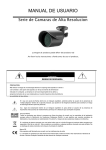
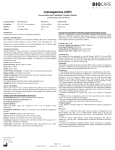
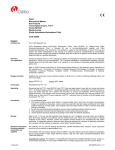
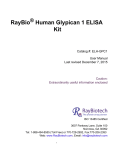
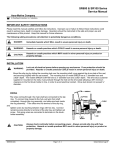
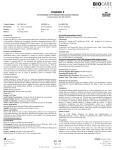
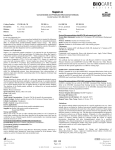
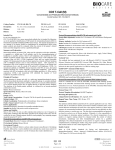
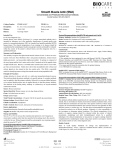
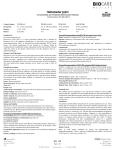
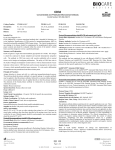
![Progesterone Receptor (PR) [16]](http://vs1.manualzilla.com/store/data/005703733_1-5d4a6a4c070c4aacc906912b3410a27a-150x150.png)
